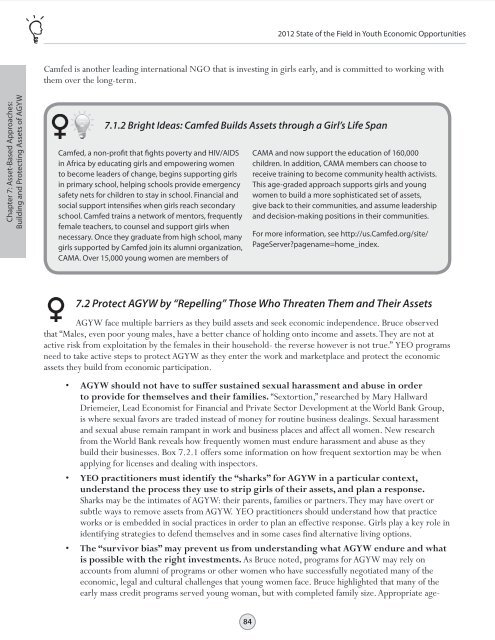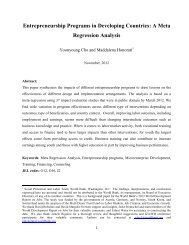STATE OF THE FIELD IN YOUTH ECONOMIC OPPORTUNITIES
STATE OF THE FIELD IN YOUTH ECONOMIC OPPORTUNITIES
STATE OF THE FIELD IN YOUTH ECONOMIC OPPORTUNITIES
You also want an ePaper? Increase the reach of your titles
YUMPU automatically turns print PDFs into web optimized ePapers that Google loves.
Table of Contents<br />
Chapter 9<br />
Chapter 1 Chapter 2 Chapter 3 Chapter 4 Chapter 5 Chapter 6 Chapter 7 Chapter 8<br />
Chapter 10 Chapter 11 Chapter 12 Chapter 13 Chapter 14 Chapter 15 Annexes<br />
2012 State of the Field in Youth Economic Opportunities<br />
Camfed is another leading international NGO that is investing in girls early, and is committed to working with<br />
them over the long-term.<br />
Chapter 7: Asset-Based Approaches:<br />
Building and Protecting Assets of AGYW<br />
7.1.2 Bright Ideas: Camfed Builds Assets through a Girl’s Life Span<br />
Camfed, a non-profit that fights poverty and HIV/AIDS<br />
in Africa by educating girls and empowering women<br />
to become leaders of change, begins supporting girls<br />
in primary school, helping schools provide emergency<br />
safety nets for children to stay in school. Financial and<br />
social support intensifies when girls reach secondary<br />
school. Camfed trains a network of mentors, frequently<br />
female teachers, to counsel and support girls when<br />
necessary. Once they graduate from high school, many<br />
girls supported by Camfed join its alumni organization,<br />
CAMA. Over 15,000 young women are members of<br />
CAMA and now support the education of 160,000<br />
children. In addition, CAMA members can choose to<br />
receive training to become community health activists.<br />
This age-graded approach supports girls and young<br />
women to build a more sophisticated set of assets,<br />
give back to their communities, and assume leadership<br />
and decision-making positions in their communities.<br />
For more information, see http://us.Camfed.org/site/<br />
PageServerpagename=home_index.<br />
7.2 Protect AGYW by “Repelling” Those Who Threaten Them and Their Assets<br />
AGYW face multiple barriers as they build assets and seek economic independence. Bruce observed<br />
that “Males, even poor young males, have a better chance of holding onto income and assets. They are not at<br />
active risk from exploitation by the females in their household- the reverse however is not true.” YEO programs<br />
need to take active steps to protect AGYW as they enter the work and marketplace and protect the economic<br />
assets they build from economic participation.<br />
• AGYW should not have to suffer sustained sexual harassment and abuse in order<br />
to provide for themselves and their families. “Sextortion,” researched by Mary Hallward<br />
Driemeier, Lead Economist for Financial and Private Sector Development at the World Bank Group,<br />
is where sexual favors are traded instead of money for routine business dealings. Sexual harassment<br />
and sexual abuse remain rampant in work and business places and affect all women. New research<br />
from the World Bank reveals how frequently women must endure harassment and abuse as they<br />
build their businesses. Box 7.2.1 offers some information on how frequent sextortion may be when<br />
applying for licenses and dealing with inspectors.<br />
• YEO practitioners must identify the “sharks” for AGYW in a particular context,<br />
understand the process they use to strip girls of their assets, and plan a response.<br />
Sharks may be the intimates of AGYW: their parents, families or partners. They may have overt or<br />
subtle ways to remove assets from AGYW. YEO practitioners should understand how that practice<br />
works or is embedded in social practices in order to plan an effective response. Girls play a key role in<br />
identifying strategies to defend themselves and in some cases find alternative living options.<br />
• The “survivor bias” may prevent us from understanding what AGYW endure and what<br />
is possible with the right investments. As Bruce noted, programs for AGYW may rely on<br />
accounts from alumni of programs or other women who have successfully negotiated many of the<br />
economic, legal and cultural challenges that young women face. Bruce highlighted that many of the<br />
early mass credit programs served young woman, but with completed family size. Appropriate age-<br />
84

















